
An icon is a religious work of art, most commonly a painting, in the cultures of the Eastern Orthodox, Oriental Orthodox, and Catholic churches. They are not simply artworks; "an icon is a sacred image used in religious devotion". The most common subjects include Jesus, Mary, saints, and angels. Although especially associated with portrait-style images concentrating on one or two main figures, the term also covers most of the religious images in a variety of artistic media produced by Eastern Christianity, including narrative scenes, usually from the Bible or the lives of saints.

Homs, known in pre-Islamic Syria as Emesa, is a city in western Syria and the capital of the Homs Governorate. It is 501 metres (1,644 ft) above sea level and is located 162 kilometres (101 mi) north of Damascus. Located on the Orontes River, Homs is also the central link between the interior cities and the Mediterranean coast.
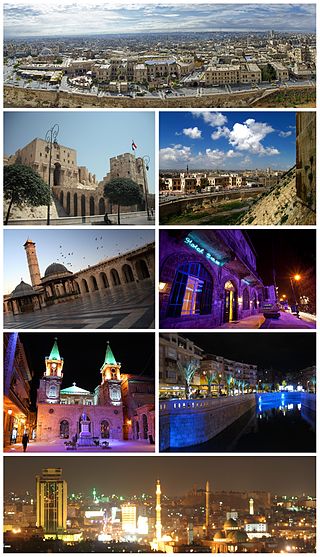
Aleppo is a city in Syria, which serves as the capital of the Aleppo Governorate, the most populous governorate of Syria. With an estimated population of 2,098,000 residents as of 2021, it was Syria's largest city until its population was surpassed by Damascus, the largest in Syria's northern governorates and also one of the largest cities in the Levant region.

The Last Judgment, Final Judgment, Day of Reckoning, Day of Judgment, Judgment Day, Doomsday, Day of Resurrection or The Day of the Lord is a concept found across the Abrahamic religions and the Frashokereti of Zoroastrianism.
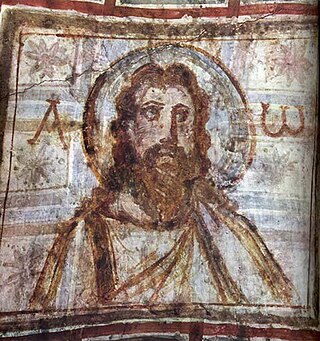
The depiction of Jesus in pictorial form dates back to early Christian art and architecture, as aniconism in Christianity was rejected within the ante-Nicene period. It took several centuries to reach a conventional standardized form for his physical appearance, which has subsequently remained largely stable since that time. Most images of Jesus have in common a number of traits which are now almost universally associated with Jesus, although variants are seen.

Maron, also called Maroun or Maro, was a 4th-century Syrian Syriac Christian hermit monk in the Taurus Mountains whose followers, after his death, founded a religious Christian movement that became known as the Maronite Church, in full communion with the Holy See and the Catholic Church. The religious community which grew from this movement are the modern Maronites.
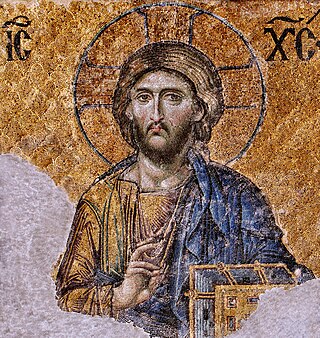
Byzantine art comprises the body of artistic products of the Eastern Roman Empire, as well as the nations and states that inherited culturally from the empire. Though the empire itself emerged from the decline of western Rome and lasted until the Fall of Constantinople in 1453, the start date of the Byzantine period is rather clearer in art history than in political history, if still imprecise. Many Eastern Orthodox states in Eastern Europe, as well as to some degree the Islamic states of the eastern Mediterranean, preserved many aspects of the empire's culture and art for centuries afterward.

A proskynetarion is a term suggesting worship and reverence, which has several concrete applications.

Deir ez-Zor is the largest city in eastern Syria and the seventh largest in the country. Located on the banks of the Euphrates River 450 km (280 mi) to the northeast of the capital Damascus, Deir ez-Zor is the capital of the Deir ez-Zor Governorate. In the 2018 census, it had a population of 271,800.

Antiochian Greek Christians are an ethnoreligious Eastern Christian group native to the Levant. They are either members of the Greek Orthodox Church of Antioch or the Melkite Greek Catholic Church, and they have ancient roots in what is now Syria, Lebanon, Palestine, Jordan, the southern Turkish province of Hatay, which includes the city of Antakya —one of the holiest cities in Eastern Christianity, and Israel. Many of their descendants now live in the global Near Eastern Christian diaspora. They primarily speak Levantine Arabic, with Maaloula near Damascus being one of the few places where a Western Aramaic dialect is still spoken.
The Armenians in Syria are Syrian citizens of either full or partial Armenian descent.
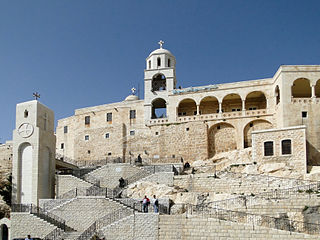
Christians in Syria made up about 10% of the pre-war Syrian population. The country's largest Christian denomination is the Greek Orthodox Church of Antioch, closely followed by the Maronite Church and the Assyrian Church of the East; the cities of Damascus and Aleppo are believed to have the largest number of Christians in Syria. There is a small minority of Protestants in the country.

Mar Ignatius Gabriel I Tappouni was a leading prelate of the Syriac Catholic Church. He served as Patriarch of Antioch from 1929 to 1968, and was elevated to the cardinalate in 1935.
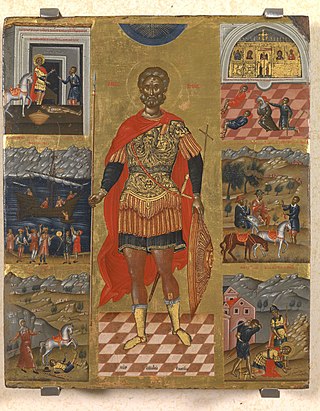
Cretan School describes an important school of icon painting, under the umbrella of post-Byzantine art, which flourished while Crete was under Venetian rule during the Late Middle Ages, reaching its climax after the Fall of Constantinople, becoming the central force in Greek painting during the 15th, 16th and 17th centuries. The Cretan artists developed a particular style of painting under the influence of both Eastern and Western artistic traditions and movements; the most famous product of the school, El Greco, was the most successful of the many artists who tried to build a career in Western Europe, and also the one who left the Byzantine style farthest behind him in his later career.
Oriental Orthodoxy is the communion of Eastern Christian Churches that recognize only three ecumenical councils—the First Council of Nicaea, the First Council of Constantinople and the Council of Ephesus. They reject the dogmatic definitions of the Council of Chalcedon. Hence, these Churches are also called Old Oriental Churches or Non-Chalcedonian Churches.

The Forty Martyrs Armenian Cathedral of Aleppo, Syria, is a 15th-century Armenian Apostolic church located in the old Christian quarter of Jdeydeh. It is significant among the Armenian churches for being one of the oldest active churches in the Armenian diaspora and the city of Aleppo. It is a three-nave basilica church with no dome. Its bell tower of 1912, is considered to be one of the unique samples of the baroque architecture in Aleppo.
Christian influences in Islam can be traced back to Eastern Christianity, which surrounded the origins of Islam. Islam, emerging in the context of the Middle East that was largely Christian, was first seen as a Christological heresy known as the "heresy of the Ishmaelites", described as such in Concerning Heresy by Saint John of Damascus, a Syriac scholar.

Patriarch MacariusIII Ibn al-Za'im was Patriarch of Antioch from 1647 to 1672. He led a period of blossoming of his Church and is also remembered for his travels in Russia and for his involvement in the reforms of Russian Patriarch Nikon.
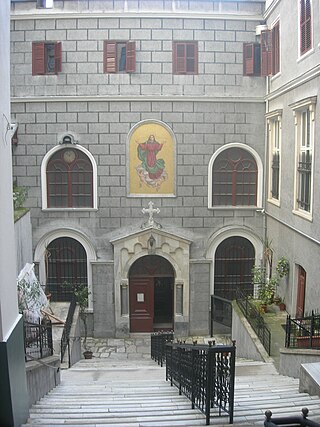
Saint Mary Draperis is a Catholic church in Istanbul, important for historical reasons. Established in 1584, the church is one of the most ancient Catholic parishes of Istanbul.

Al-Jdayde is a historic predominantly Christian neighbourhood of Aleppo. It is noted for its winding narrow alleys, richly decorated mansions and churches. It was an area of significant cultural and historical interest. Much of Al-Jdayde suffered catastrophic damage during the Syrian Civil War.
















